Gregynog National Nature Reserve, Nr. Newtown, Powys, East Wales
Designations: Includes Gregynog SSSI
Below: An ancient oak tree in the Great Wood at Gregynog National Nature Reserve
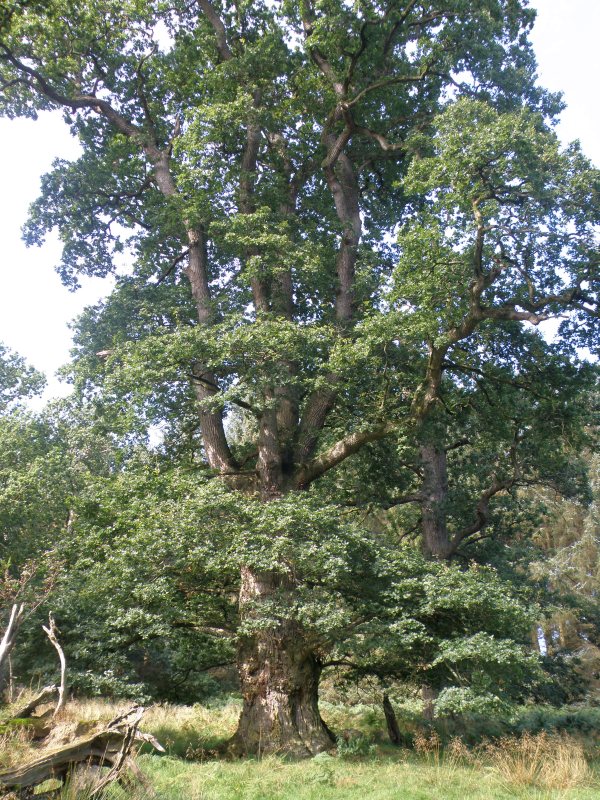
Gregynog was the last National Nature Reserve to be designated in Wales under the auspices of the Countryside Council for Wales (CCW). The declaration was formalised by CCW on the Monday 10th September 2012. CCW now forms part of Natural Resources Wales (NRW).
At first Gregynog - better known as Gregynog Hall, a famous high-class venue for weddings, conferences and other events - seems an unlikely place to host a NNR, but it is also famous for its gardens and grounds, part of which is already designated as an SSSI. This SSSI, which was extended in 2011, forms the heart of the new National Nature Reserve. The pre-existing SSSI status of this immensely valuable wildlife resource highlighted the importance of the woodland and parkland habitats, where ancient trees support rare and endangered species of lichens and insects. But Gregynog NNR supports very many more species of wildlife, and as a result birdwatchers, micologists and botanists will be equally at home there.
We visited this lovely place on a sparkling early autumn morning and spent the better part of a day exploring the numerous and varied habitats found throughout the estate. I would defy anybody with an interest in the natural world not to have an enjoyable and interesting time at Gregynog, and for those more interested in historical buildings it is possible to visit the Hall itself and stroll around the magnificent formal gardens which surround it.
The site is owned and managed by the University of Wales. Management of the conservation objectives is carried out in association with Natural Resources Wales (NRW).
Below: Gregynog Hall viewed through the trees of the Great Wood
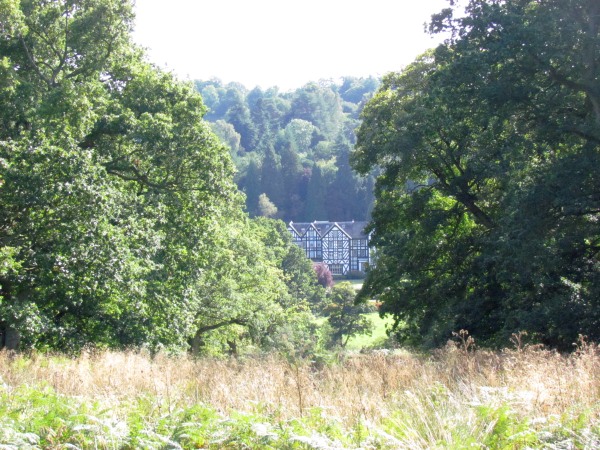
Directions
Grid Ref: SO 085976
From Newtown, in Powys, take the A483 towards Welshpool. After approximately 4 kilometres turn left onto the B4389 signed to Llanfair Caereinion and Bettws Cedewain. Continue along this road until you come to a crossroads and you will see the sign for Gregynog immediately opposite. Proceed down the drive to the Hall and car park.
Access
This reserve is open throughout the year.
Although the terrain is uneven and steep in places, particularly through Great Wood, and not suitable for wheelchair users or for prams, many parts of the estate have excellent access. Walkers in the Great Wood need to be careful of slippery, steep sections of the path and should wear good, stout, waterproof footwear.
Below: The Courtyard Cafe and gift shop at Gregynog
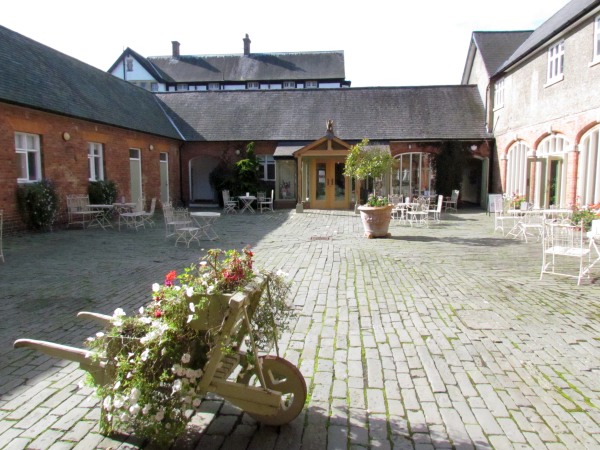
Facilities
There is a large car park close to Gregynog Hall for which there is a daily charge of £2.50 per day, while entrance to the formal gardens costs £3 per visit (2012 rates). There is a high-class gift shop and an excellent cafe in the Courtyard close to the main car park, and there are public toilets. Gregynog Hall also operates an annual membership scheme enabling those in a position to visit the hall on a regular basis to cut down on costs. There are also special parking areas for members.
There is a network of colour-coded walks which wind their way through the estate, enabling visitors to gain access to all the most important wildlife habitats. Maps of the walks are available from the gift shop and cafe.
Interpretation boards throughout the estate alert visitors to the wildlife species they are most likely to encounter in the various habitats found in the grounds.
Description of Site
In order to help people to pursue particular interests this description is divided into the specific areas, which include ancient parkland and woodland pastures, semi-natural woodland, dry and marshy grassland, streams, pools and ponds all accessible via the many walks throughout the estate.
Great Wood
Wales in general is not over-endowed with ancient or even veteran trees, and some of the precious woodland pasture habitats in Gregynog NNR are dwindling features throughout Europe. Gregynog's importance as a place to study ancient trees and the numerous species of wildlife that such trees support was highlighted in 2011 when it hosted the Ancient Tree Forum. New wildlife species are still be recorded for the site including two species of lichen new to Wales found during the course of the same year.
Trees found in the Great Wood (and the area called The Warren - see below) include ancient Oaks, Beeches and Ash trees of truly gargantuan proportions. These combined with the many other tree species found there make the wood an ideal habitat for many birds, insects, bats, fungi and in particular lichens. More than 180 lichen species have been recorded at Gregynog NNR including Calicium adspersum, Lecanographa amylacea, Lecanora quercicola and Lecanora sublivescens. Suitable habitats for lichens, which have very particular requirements, are in steep decline throughout the UK. Lichens don't only require old trees but also very clean air. Atmospheric pollution has had a devasting effect on the diversity and richness of lichens throughout Britain.
The Stinkhorn Phallus impudicus is one of numerous fungi to be found at Gregynog NNR.
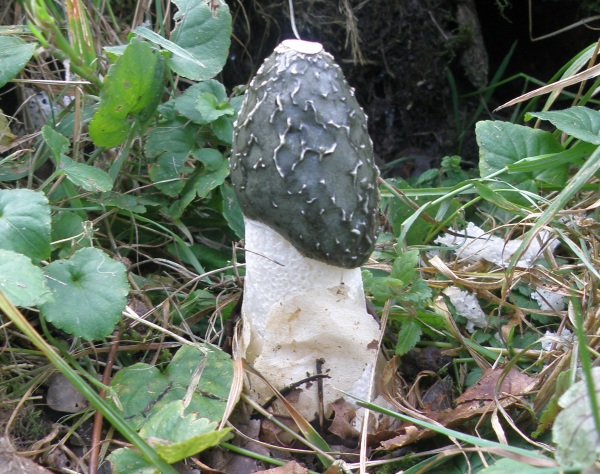
Birds found in the Great Wood include all three of the woodpeckers native to Britain: the Great Spotted Woodpecker Dendrocopos major, the Lesser Spotted Woodpecker Dendrocopos minor and the Green Woodpecker Picus viridis. The latter is not as common in Wales as it is in other parts of the UK and is easily identified by its screaming call even when not visible. Although they inhabit and build their nests in trees, Green Woodpeckers are frequently seen on the ground and are particularly fond of short swards and lawns from which they extract insects with their short dagger-like beaks.
Another intriguing British resident bird seen at Gregynog is the Treecreeper (Certha familiaris). Although widespread, Teecreepers are often very difficult to spot because they are so perfectly camouflaged as they move slowly and quietly up and down tree trunks, using their sharply down-curved beaks to pry insects from crevices in the bark.
While walking in the Great Wood look out for Long-tailed Tits Aegithalos caudatus and Nuthatches Sitta europaeawhich are also residents. The bird population is increased considerably when the spring migrants arrive to build their nests and raise families during the summer months. These include the Pied Flycatcher Ficedula hypoleuca, Spotted Flycatcher Musicapa striata and the Common Redstart Phoenicurus phoenicurus.
The Great Wood and other parts of Gregynog NNR provide foraging areas for a number of Britain's bat species including the Lesser Horseshoe Bat Rhinolphus hipposideros and the Barbastelle Bat Barbastella barbastellus.
Rare insects that inhabit the Great Wood include the Greater Thorn-tipped Longhorn Beetle Pogonocherus hispidulus, the Cobweb Beetle, Tanback Borer Longhorn Beetle Phymatodes testaceus, Black Clouded Longhorn Beetle Leiopus nebulosus, Speckled Longhorn Beetle and Narrow Timber Beetle Bitoma crenata.
The Great Wood is also a good place to see many of the fungi species which occur at Gregynog NNR during the autum. Even though our visit was early in the fungi season we saw many species, of which Giant Polypore Meripilus giganteus, Beefsteak Fungus Fistulina hepatica and Stinkhorn Phallus impudicus were of particular note.
Below: Giant Polypore Meripilus giganteus
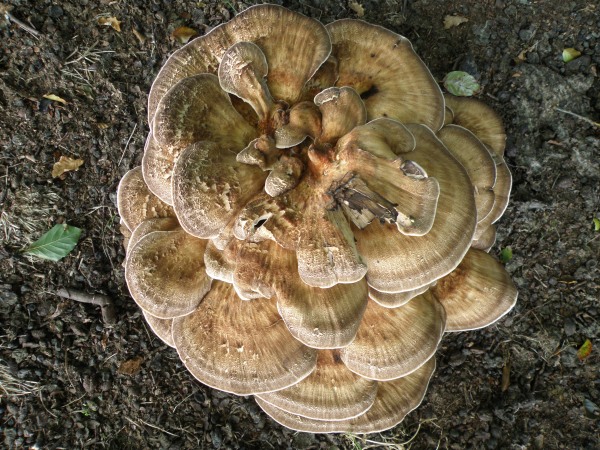
Below: Beefsteak Fungus Fistulina hepatica
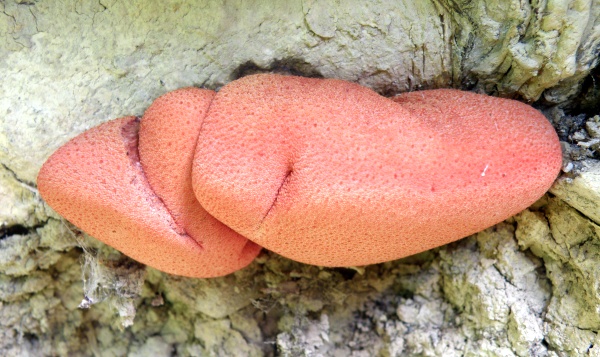
The Warren
The part of the Gregynog Estate known as The Warren gets its name from the countless rabbits which used to inhabit the area in the days before Myxomatosis devasted rabbit populations. Today rabbits are still frequently seen throughout the estate but not in the numbers previously known.
The Warren is of great conservation value and home to many interesting birds, insects and mammals as well as some rare lichens that cling to the trees there.
In early spring the Hawthorn bushes in The Warren are a froth of white flowers which are literally smothered in insects visiting for the generous nectar reward the flowers give in exchange for help with pollination.
Spring is also a good time to catch a glimpse of Brown Hares (Lepus capensis), once a common site in the British countryside but now very rare. Other mammals seen in this part of Gregynog NNR are Badgers Meles meles, Polecats Mustela putorius and Hedgehogs Erinaceus europaeus. Polecats were persecuted by gamekeepers in the past, and Wales is one of the few places where there is still a realistic hope of seeing them, although they are generally nocturnal and very secretive creatures. The Brown Hare was also persecuted but its decline is also attributable to wholesale habitat destruction brought about by agricultural policy and modern farming methods.
In wintertime, The Warren is a good place to see Fieldfares Turdus pilaris and Redwings Turdus iliacus as they fly south from northern European countries. Large flocks call in to feed on the huge harvest of Hawthorn and other berries that cling on to the trees and bushes in the estate well into the coldest months of the year.
Below: The Lily Lake was restored and re-opened in 2010
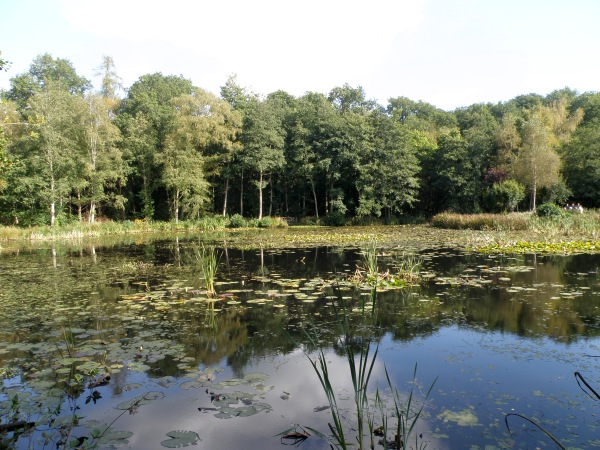
The Lily Lake
All three British newt species are recorded at Gregynog NNR along with the Common Frog Rana temporaria and Common Toad Bufo bufo. The Smooth Newt Lissotriton vulgaris and the Palmate Newt Lissotriton helvetica are both common and widespread in mainland Britain, but the Great Crested Newt Triturus cristatus is much rarer and extremely localised. The Great Crested Newt is the largest of our newts and lives in large weedy ponds, making Lily Lake a perfect choice of home. The male Great Crested Newt becomes more brightly coloured during the mating season in spring, when it sports an orange, black-spotted belly with dark spotted flanks. Unlike our other native newts, which leave their ponds and live under logs in summer and winter, the Great Crested Newt spends most of the year living in its chosen pond or lake.
The Lily Lake is a good place to see Kingfishers Alcedo atthis, which perch in the margins of the lake and wait for unsuspecting prey in the form of small fish or insects to reveal themselves. Other birds in the lake include Mallards Anas platyrhynchos, Coots Fulica atra and Moorhens Gallinula chloropus. Little Grebes Tachybaptus ruficollis are also seen on the lake from time to time. Although relatively common throughout Britain, the Little Grebe is a shy bird and seldom spotted: its presence is far better recognised from the sound of its whinnying call than by an actual sighting.
Lily Lake is surrounded by dense stands of rushes and other plants. In early summer Yellow Iris Iris pseudacorus is a feature, and later Meadowsweet Filipendula ulmaria creates a white lacey collar around the pool. The plantlife around the lake makes it an ideal spot for seeing insects, and despite the lateness of our visit there were numerous dragonflies buzzing around the margins.
Gregynog NNR is a great place to visit at any time of the year if you want to see some of Wales's most special wildlife species: in springtime there are stands of Bluebells Hyacinthoides non-scripta in the woodland areas, and it is not long before the spring migrant birds put in an appearance. In summer the estate is full of colour, and alive with the myriad moths, butterflies and other insects that depend on flowering plants for their survival. Autumn sees the arrival of fungi in the woods and grasslands, and winter is a great time to admire the numerous mosses and lichens in the reserve and to see some of the birds that call in to take refuge on their long and perilous migration journeys.